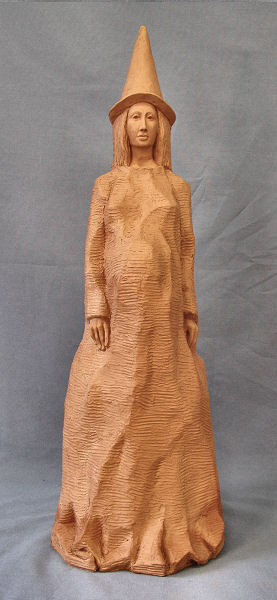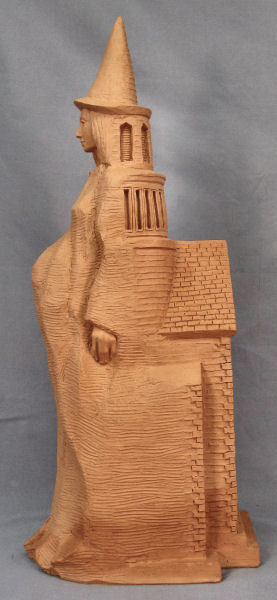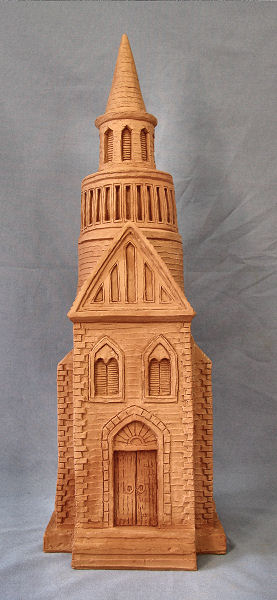All fanatical, organized religion
suppresses women with
an endlessly creative and unfathomable myriad of atrocities.
It is the stuff of nightmares. It is the stuff of hell.
Suppression subtle and gross,
Suppression covert and overt,
Suppression conscious and unconscious.
Suppression insidious.
Suppression incessant.
Suppression systemic.
Yet…
How can you hide the moon?
How can you hold back the tides?
How can you crush the wind?
How can you cool the burning fires that smolder in the deep of the
earth?
How can you tame Woman?
------------Womansculpture —April 5, 2008
(These words can be applied to any group of people who have been
suppressed. In stead of the word “woman”, substitute: Dalits,
Blacks, Jews, Lesbians, Gays….this list can go on and on. However, I
am specifically addressing the struggles of women through this
sculpture. Also, when I speak of fanatical, organized religion or
the patriarchy that suppresses women I am not speaking exclusively
about men. Rather the patriarchy represents the cultural oppression
of women by both men and women. I will go on to say that I believe
that humanity can be seen as whole and when women are suppressed,
the men in the culture are also greatly damaged. However, Which
Church is addressing the pain felt by women, yet this is not to say
that men are not in need of healing, and have not suffered brutally
through ridged dogmatic structures. Further, the Son of God should
be reveled in and honored, however, rigidly organized religion, and
the patriarchy have distorted the balanced yin-yang between men and
women.)
Isadora Duncan succinctly states “No, I can't explain the dance to
you; if I could say it--I wouldn't have to dance it!” And so,
although I can relate the symbols I have used, and how I have chosen
to arrange the elements of art, and why I have ordered the
principles of art in such a way, and my historical references, and
the mood, and what I hope you might take with you, I can’t explain
the sculpture to you. I am sorry, and it pains me, because art is
about communication, and I want to have that shared experience with
you that will bind our hearts together. And I worry fiercely that I
did not get my ideas across clearly and convey the layers of meaning
this piece holds for me. No, I can’t explain the art to you. Yet, I
will never stop trying. My art is married to the written word. My
right brained images are in a synergistic relationship with my left
brain words; they uphold one another like music and lyrics.
Looking up at the spire of an old church, the kind one sees in New
England, I noticed the spire reminded me of a witch’s hat. I have
had the idea for Which Church living in my head for several years
now. Sometimes a sculpture lives in my head, and although it is a
good idea, it does not need to breath in the world; living in my
head is good enough for the both of us. But, this image kept
flashing across my mind’s eye. My relationship to witches is to see
them as wise women, the women who gave medicines to other women to
ease labor pains during child birth.
Upon entering the gallery, the viewer sees only the front of Which
Church, a building, and then as they walk around the piece they are
surprised to see a witch at the back of the piece. Therefore, the
front of the piece must be the church because this is the story I am
telling: a history that tries to suppress the feminine, but can not.
And, this is how things often are. At first glance we are only shown
the male aspects, and yet, on closer inspection we see the almost
invisible fingerprints of women—everywhere, yes, everywhere.
Bernini’s Medusa, housed at the Palazzo dei Conservatori in Rome,
the snakes writhe out of control, turning upon and attacking each
other. Medusa’s face is anguish. Women in history have suffered, and
one might imagine their faces, like Bernini’s Medusa, hardened like
marble masks of pain. Yet, women have resolve at their core and can
garment themselves in that strength. Therefore, the horizontal lines
of my Witch-Church’s robes speak of that quiet strength.
Proportion is a consideration for this piece. Ideally, I would have
liked the piece to be bigger; this is because the viewer needs to be
shocked, surprised by the size of the witch: she is as magnificent
and as grand as the church. Unfortunately, I do not make sculptures
as large as I would like because I don’t have the room for them in
my home, and I don’t have the physical strength to chuck them around
my studio. I was assured when I saw a show of Dali’s paintings and
was struck by how small his canvases are, and yet how much he was
able to pack into such a small space--petit, yet powerful. Also, how
the piece is shown will impact on its effectiveness—I will
compensate for her lack of size by placing Which Church above eye
level with the viewer to make her seem larger than she is.
I was talking with Verna Robinson, my mom, about my work and I was
reflecting on how many of the women in my sculptures have a
reserved, or intellectual distance about them, a feeling of
coolness. Mom and I discussed how that coolness relates to the
verity that these women can not be owned, they can not be bought.
They have a strength and self-containment about them that can be
perceived as cool. Sometimes, we expect our women to be warm and
nurturing, like a Mary Cassatt painting, and when they are not, we
can feel abandoned by the Mother archetype.
Why she is the witch pregnant? Why are so many of my figures
pregnant? The faces on my Jana sculpture have been mistaken as men’s
faces; they are not men’s faces, they are
women’s faces. I don’t want my work to be perceived as either made
by a man, or that my figures are male, and that my work comments on
the male experience and point of view. This fate has been common
among women artists throughout history. Either their work has been
interpreted from a male’s point of view, or the work has been
attributed to male artists. Rarely, do men depict pregnant women.
Instead, men often depict women as sexual beings, or the virgin
archetype. When a woman is pregnant she is no longer seen as an
object of desire by other men who strive to perpetuate their own
genetic line. A pregnant is already committed to another man, and is
no longer as desirable, or accessible. I also use pregnancy as
metaphor for life and unknown potential that is ready to burst forth
into consciousness.
The front of this sculpture, the church, represents the solar or
masculine aspects of fanatical and rigid religious systems. The back
shows the lunar or feminine traits of humanity that have survived
the genocide of gender. This piece specifically references the witch
hunts that took place in Europe and the New England states, yet the
piece is universal enough to encompass other trials our wise women
have faced through out history and that we face, in legion, today.
The church and the witch are joined together in much the same way
the yin yang’s light and dark portions join to compose a complete
circle. The known and the unknown; male and female; front yard and
back yard; the predictable and the unpredictable; the civilized and
the primitive, the conscious and the unconscious: each of these
pairs join together to form a whole and inform and shape the other.
Conversely, Which Church as yin-yang parts that complete each other
also speak to conflicting ideas that suffocate one other with their
bound proximity. The dichotomy of these two ideas: that of the
yin-yang that forms a whole, and that of two opposites bound
together in a prison like suffocation can exist side by side and do
not negate the other.
When I was a young girl I was captivated by the story of King
Arthur’s daughter Burd Ellen. I did not remember Burd Ellen until
after I had finished Which Church, and yet I know her story spoke to
me from deep in the crevices of my mind. The Warlock Merlin explains
that “because she went round the church windershins—opposite to the
sun, she is now in the dark Tower of Elfland.” The story concludes
“They reached home safely and were welcomed with great joy by fair
Gwenevera, their queen mother. And never again did Burd Ellen go
round the church or churchyard windershins.” (Katharine Gibson, 1901
pg. 59-68). Windershins means counterclockwise or against the sun.
When we go against the sun, or against the Son of God, as expressed
in rigid dogma, and turn windershins we delight in what is right
brained, lunar and we discover the feminine, we see the witch behind
the church, we see alongside the Son of God, the Daughter of the
Divine, and we know that it is good.
|






